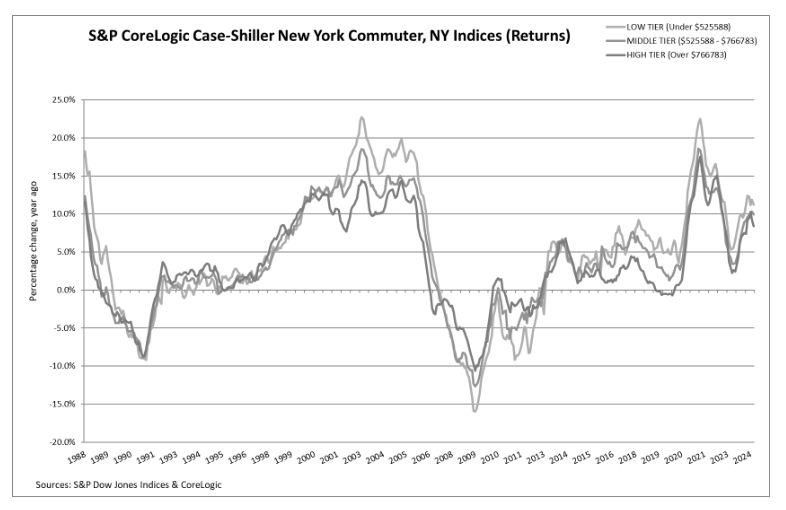NEW YORK, AUGUST 27, 2024: S&P Dow Jones Indices (S&P DJI) today released the June 2024 results for the S&P CoreLogic Case-Shiller Indices. The leading measure of U.S. home prices reached a new all-time high with a decelerating trend for June 2024. More than 27 years of history are available for the data series and can be accessed in full by going to https://www.spglobal.com/spdji/en/index-family/indicators/sp-corelogic-case-shiller/.
YEAR-OVER-YEAR
The S&P CoreLogic Case-Shiller U.S. National Home Price NSA Index, covering all nine U.S. census divisions, reported a 5.4% annual gain for June, down from a 5.9% annual gain in the previous month. The 10-City Composite saw an annual increase of 7.4%, down from a 7.8% annual increase in the previous month. The 20-City Composite posted a year-over-year increase of 6.5%, dropping from a 6.9% increase in the previous month. New York reported the highest annual gain among the 20 cities with a 9.0% increase in June, followed by San Diego and Las Vegas with annual increases of 8.7% and 8.5%, respectively. Portland once again held the lowest rank for the smallest year-over-year growth, notching a 0.8% annual increase in June.
The chart below compares year-over-year returns for different housing price ranges (tiers) in New York.

MONTH-OVER-MONTH
The U.S. National Index, the 20-City Composite, and the 10-City Composite upward trends continued to decelerate from last month, with pre-seasonality adjustment increases of 0.5%, 0.6%, and 0.6%, respectively.
After seasonal adjustment, the U.S. National Index posted a month-over-month change of 0.2%, while the 20-City and 10-City Composite reported a monthly change of 0.4% and 0.5%, respectively.
ANALYSIS
“The S&P CoreLogic Case-Shiller Indices continue to show above-trend real price performance when accounting for inflation,” says Brian D. Luke, CFA, Head of Commodities, Real & Digital Assets. “Home prices and inflation continue to factor into the political agenda coming into the election season. While both housing and inflation have slowed, the gap between the two is larger than historical norms, with our National Index averaging 2.8% more than the Consumer Price Index. That is a full percentage point above the 50-year average. Before accounting for inflation, home prices have risen over 1,100 percent since 1974, but have slightly more than doubled (111%) after accounting for inflation.
“Another popular theme is making housing more affordable to first-time homebuyers. We compared each of the 16 markets that the S&P CoreLogic Case-Shiller Home Price Indices calculate on a tiered basis to evaluate historical performance of more affordable homes. Our tiered indices divide each market into three price tiers, which range based on the market. Looking at the last five years, 75% of the markets covered show low-price tiers rising faster than the overall market,” according to Luke. “For example, the lower tier of the Atlanta market has risen 18% faster than the middle- and higher-tiered homes. New York’s low tier has the largest five-year outperformance, rising nearly 20% above the overall New York region. New York also has the largest divergence between low- and high-tier prices. New York’s high-tier homes have lagged the region’s market by 5.1%. Conversely, San Diego has seen the largest appreciation in higher-tier homes over the past five years. While the overall San Diego market has risen by 72% in the past five years, the high tiers have done even better, rising 79% versus 63% for the lower tier.”













































